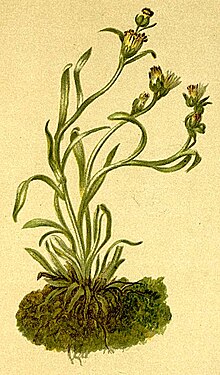Hoppes Ruhrkraut
| Hoppes Ruhrkraut | ||||||||||||
|---|---|---|---|---|---|---|---|---|---|---|---|---|

Hoppes Ruhr herb ( Gnaphalium hoppeanum ) |
||||||||||||
| Systematics | ||||||||||||
|
||||||||||||
| Scientific name | ||||||||||||
| Gnaphalium hoppeanum | ||||||||||||
| WDJKoch |
Hoppes Cudweed ( Gnaphalium hoppeanum ) is a plant from the family of the daisy family (Asteraceae).
features
Hoppes Ruhrkraut is a perennial herbaceous plant that reaches heights of up to 10 cm. It usually has several, thin, simple and little leafy stems . The leaves are densely tomentose, lanceolate, with entire margins and single-nerved.
In a terminal total inflorescence with leaves at the base , a few 5 to 7 mm long cup-shaped inflorescences stand together. The imbricated bracts have a brown-black border. The hermaphroditic tubular flowers are brownish. One randliche row of ray florets are female with a fädlichen tongue.
The achenes have a white pappus .
The flowering period extends from July to August.
The chromosome number of the species is 2n = 28.
Occurrence
The distribution area is in the mountains of Central and Southern Europe. The distribution area includes Spain, Andorra, France, Italy, Switzerland, Germany, Austria, Liechtenstein, Slovenia, the Balkan Peninsula, Poland and Slovakia. At altitudes between 1500 and 2650 meters, Hoppes Ruhrkraut only thrives on chalky, moist soils . Hoppes Ruhrkraut is rare. It is a character species of the Arabidion caeruleae association.
In the Allgäu Alps, the species rises from the Schönbergalpe near the Riedbergerhorn in Bavaria at 1400 m above sea level up to 2300 meters.
literature
- Xaver Finkenzeller, Jürke Grau: Alpine flowers (Steinbach's natural guide), Mosaik Verlag, Munich 1985, ISBN 3-570-01349-9 .
Individual evidence
- ↑ a b Erich Oberdorfer : Plant-sociological excursion flora for Germany and neighboring areas . 8th edition. Stuttgart, Verlag Eugen Ulmer, 2001. Page 919. ISBN 3-8001-3131-5
- ↑ Werner Greuter (2006+): Compositae (pro parte majore). - In: W. Greuter & E. von Raab-Straube (eds.): Compositae. Euro + Med Plantbase - the information resource for Euro-Mediterranean plant diversity. Datasheet Gnaphalium hoppeanum In: Euro + Med Plantbase - the information resource for Euro-Mediterranean plant diversity.
- ↑ Erhard Dörr, Wolfgang Lippert : Flora of the Allgäu and its surroundings. Volume 2, IHW, Eching 2004, ISBN 3-930167-61-1 , p. 580.

